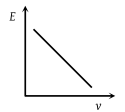The force acting on a body moving along x-axis varies with the position of the particle as shown in the fig.

The body is in stable equilibrium at
(1) x = x1
(2) x = x2
(3) both x1 and x2
(4) neither x1 nor x2

The potential energy of a particle varies with distance x as shown in the graph. The force acting on the particle is zero at
(1) C
(2) B
(3) B and C
(4) A and D
Figure shows the F-x graph. Where F is the force applied and x is the distance covered by the body along a straight line path. Given that F is in newton and x in metre, what is the work done ?
(1) 10 J
(2) 20 J
(3) 30 J
(4) 40 J
The force required to stretch a spring varies with the distance as shown in the figure. If the experiment is performed with the above spring of half length, the line OA will
(1) Shift towards F-axis
(2) Shift towards X-axis
(3) Remain as it is
(4) Become double in length
A body moves from rest with a constant acceleration. Which one of the following graphs represents the variation of its kinetic energy K with the distance travelled x ?
(1)
(2)
(3)
(4)
The diagrams represent the potential energy U as a function of the inter-atomic distance r. Which diagram corresponds to stable molecules found in nature.
(1)
(2)
(3)
(4)
The relationship between the force F and the position x of a body is as shown in the figure. The work done in displacing the body from x = 1 m to x = 5 m will be:
| 1. | 30 J | 2. | 15 J |
| 3. | 25 J | 4. | 20 J |
A particle is placed at the origin and a force F = kx is acting on it (where k is positive constant). If U(0) = 0, the graph of U(x) versus x will be (where U is the potential energy function)
(1)
(2)
(3)
(4)
Two identical balls \(\mathrm{A}\) and \(\mathrm{B}\) having velocities of \(0.5~\text{m/s}\) and \(-0.3~\text{m/s}\) respectively collide elastically in one dimension. The velocities of \(\mathrm{B}\) and \(\mathrm{A}\) after the collision respectively will be:
1. \(-0.5 ~\text{m/s}~\text{and}~0.3~\text{m/s}\)
2. \(0.5 ~\text{m/s}~\text{and}~-0.3~\text{m/s}\)
3. \(-0.3 ~\text{m/s}~\text{and}~0.5~\text{m/s}\)
4. \(0.3 ~\text{m/s}~\text{and}~0.5~\text{m/s}\)






















